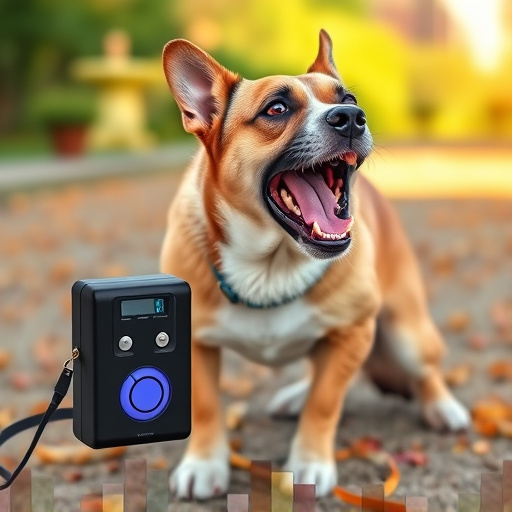Ultrasonic dog repellents emit high-pitched frequencies to deter canines without harm, but regular attention to low battery warning signs—like decreased range or sudden shutdowns—is crucial for optimal performance. Maintain devices through charging after use, sensor inspection, cleaning, and monitoring operational changes; replace when effectiveness wanes, especially with certain dog breeds, considering alternative methods like spray repellents that are pet-safe and eco-friendly.
Tired of unwanted dog invasions? Discover the power of dog repellers with an effective frequency range. This comprehensive guide unravels the technology behind these deterrents, exploring the science of specific frequencies and their impact on canine behavior. Learn to recognize crucial low battery warning signs for optimal performance. We also dissect best practices and offer alternative solutions when traditional methods fall short.
- Understanding Dog Repeller Technology: How It Works
- The Science Behind Effective Frequency Ranges
- Identifying Low Battery Warning Signs in Your Dog Repeller
- Best Practices for Maintaining Optimal Performance
- Alternative Solutions and When to Consider Them
Understanding Dog Repeller Technology: How It Works
Dog repellents utilize specific frequencies to deter canine intrusion, employing a technology that converts sound into an invisible barrier. These devices emit high-pitched tones, often beyond human hearing, which activate when triggered by movement or proximity to the protected area. The ultrasonic waves create discomfort for dogs, encouraging them to avoid the vicinity without causing harm. This non-invasive approach is particularly effective in gardens, patios, or public spaces where a visible fence might be unappealing.
Regularly checking for low battery warning signs is crucial for optimal performance. Most dog repellers display indicators when power levels deplete, allowing users to replace batteries promptly. Neglecting this maintenance can lead to unexpected malfunctions during operation, potentially reducing the device’s effectiveness as a deterrent.
The Science Behind Effective Frequency Ranges
The science behind effective frequency ranges in dog repellents lies in understanding how sound waves interact with animals’ senses. Dogs, like humans, have a certain range of hearing frequencies they can detect. Repellers use specific tones within this range to create an unpleasant auditory experience for dogs without causing them harm. These sounds are often in the higher-frequency spectrum, above what humans can hear comfortably, making them targeted and effective.
Regularly checking for low battery warning signs is crucial when using these devices. Many repellers have LED indicators that signal when the battery needs replacing, ensuring their effectiveness isn’t compromised. Dog owners should stay vigilant, as a dying battery could render the repellent useless, negating its protective benefits. Prompt replacement is key to maintaining a reliable barrier against unwanted canine visitors.
Identifying Low Battery Warning Signs in Your Dog Repeller
If your dog repellent is starting to lose its effectiveness, it could be a sign that the battery is running low. Pay attention to certain warning signs to ensure optimal performance. One of the most noticeable indicators is a significant decrease in the device’s range or intensity; if you find that the repellent is not deterring your pet as effectively as it used to, this could be due to a drained battery. Another telltale sign is when the device suddenly stops working midway through use—it might be time for a replacement.
Regularly checking the device’s power level and following the manufacturer’s guidelines on battery maintenance are crucial. Many modern dog repellents feature low-battery indicators, often in the form of flashing lights or beeps. Keep an eye out for these alerts to stay one step ahead and avoid any unexpected malfunctions. Regular replacement of the batteries, as recommended by the manufacturer, is key to maintaining the repellent’s efficiency and ensuring it works when you need it most.
Best Practices for Maintaining Optimal Performance
To maintain optimal performance from your dog repellent, regular maintenance and awareness of low battery warning signs are crucial. Firstly, ensure proper charging after each use, as a depleted battery can significantly reduce the device’s effectiveness. Secondly, check for any signs of damage or wear, especially on the connections and sensors, as these components play a vital role in signal transmission. Regular cleaning is also beneficial to remove any debris that might hinder its operation.
Additionally, be attentive to changes in operating range and intensity. If you notice the device’s range decreasing over time, it could indicate a battery issue or potential interference from environmental factors. Keep an eye out for warning signs like dimmed lights, reduced sound output, or unexpected malfunctions, as these may signal that it’s time for a battery replacement.
Alternative Solutions and When to Consider Them
While dog repellents using ultrasonic frequencies are popular, it’s essential to consider alternative solutions for effective pet control. Not all dogs or people find these high-pitched sounds off-putting, especially younger or more aggressive animals. In such cases, traditional training methods or different repellents might be more suitable. For instance, spray repellents can be used outdoors to discourage dogs from entering specific areas, but always ensure they are pet-safe and environmentally friendly.
Knowing when to switch strategies is key. If your current dog repellent shows signs of a low battery—a critical warning sign—it may no longer be effective. Similarly, if your method isn’t deterring your dog or other nearby animals, it’s time to explore alternatives. Dog behavior varies, and what works for one might not work for another; thus, adapting your approach is vital for successful pet management.
In summary, a dog repeller with an effective frequency range is a reliable tool for deterring unwanted canine intruders. By understanding the technology and science behind these devices, you can ensure optimal performance through proper maintenance. Staying vigilant for low battery warning signs and considering alternative solutions when necessary will further enhance their effectiveness. Remember that the right dog repeller, used judiciously, can be a game-changer in maintaining a peaceful outdoor space.
